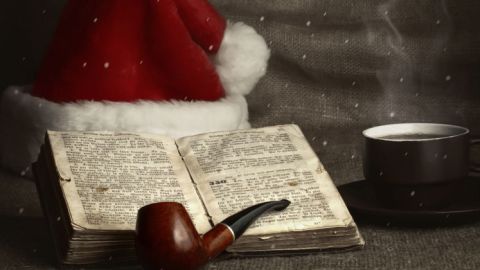The Meaning of “The Meaning of Christmas”

“Isn’t there anyone who knows what Christmas is all about?” —A Charlie Brown Christmas
Sure, Charlie Brown, I can tell you. But the answer involves a little textual analysis. After all, where does Christmas come from, if not books?
I don’t mean the rituals of the holiday, most of which are organic products of folk tradition. I mean the idea—or ideal—behind the holiday, which like so many big ideas traces back to a small scattering of words on paper.
Despite the centuries of tradition surrounding it, Christmas has just three crucial literary sources. The first is the Nativity story in the Gospels. The second is Dickens’s A Christmas Carol. The third is the poem “A Visit From St. Nicholas,” also known as “The Night Before Christmas.” More than any other influences, these works—four chapters of Biblical verse, a slim novella, and a fifty-six-line comic poem—have created the modern holiday.
As told in the Gospels of Luke and Matthew, the Nativity story sketches the core sentiments and values (charity, compassion, wonder) around which Christmas revolves. Brief as it is, it’s the source to which all later texts, no matter how secular or satirical, pay homage. In answer to Charlie Brown’s question, Linus—always handy with an apt quotation—recites a few verses of Luke verbatim. It’s a rhetorical triumph, but there’s a bit more to the story.
Dickens’s A Christmas Carol is the longest of the three main texts and is widely credited with reinventing, if not saving, Christmas. The holiday’s popularity was at a low ebb when the novella emerged in 1843; many of the customs associated with the season (caroling, for example) were on the wane. Dickens’s heartwarming ghost story became a runaway bestseller and went a long way toward bringing Christmas back into vogue.
A Christmas Carol is a moral tale, but while it reinforces the traditional virtues of charity and compassion, it also subtly plumps for the hedonistic element of the Christmas spirit. Scrooge is not just a miser but an ascetic miser, resisting material extravagance as much as he does connection with his fellow man. His poorer acquaintances, by contrast, enjoy what little they’ve got to the fullest. The book provides our most durable images of the heartily celebrated holiday: old Fezziwig dancing at the office party, the Cratchit family salivating over their meager goose. As a CNN correspondent nicely put it some years back: “A Christmas Carol really isn’t about Jesus Christ. What it’s about is good times and goodwill and good food.” I like how he runs those three items together; despite all the finger-wagging popular sermons against the materialism of Christmas, I think it’s natural to want to wrap love and plenty into one bundle, indulgently given and received. Certainly that’s the impulse at the heart of Dickens’s nostalgia, which has become much of the Western world’s.
“A Visit From St. Nicholas” (1823) is the primary source of the popular image of Santa Claus, and hence of the Santa industry. Combining several previous incarnations from tradition and folklore—St. Nicholas the historical bishop, Sinterklaas, Father Christmas—the poem helped standardize the depiction of Santa as a “jolly old elf” with a team of flying reindeer. It’s also the major touchstone for the notion of Christmas as magical, an event to be breathlessly awaited (all those visions of sugarplums) and mysteriously and thrillingly consummated. There’s no conflict in the poem, just the tingle of fear that accompanies the unknown. Even that pulse-pounding sensation soon gives way to—whee!—toys. It’s a fairy tale without a moral, and it’s helped turn Christmas into the ultimate non-threatening, kid-friendly holiday. (The version of Santa who brings lumps of coal is now a joke at most.)
Think my core Christmas canon is too narrow? You won’t have to expand it by much to match the scope of influence I’ve claimed for it. Throw in O. Henry’s “The Gift of the Magi,” the first two chapters of Alcott’s Little Women, Hoffmann’s “The Nutcracker and the Mouse King,” and Dr. Seuss’s How the Grinch Stole Christmas!, andyou’re still shy of 250 pages. Now try this: imagine The Perfect Christmas. (Whether you celebrate the holiday or not, marketing has surely familiarized you with the concept.) If your vision isn’t derived from one or more of the works already mentioned, or an adaptation thereof, you’re either thinking of It’s a Wonderful Life (based on a short story and containing strong elements of Dickens), or else remembering an insanely happy childhood.
As all of the above suggests, Christmas is not a single holiday so much as several kinds of celebration grafted together. It’s a religious holiday, a commercial holiday, a family holiday, a fun holiday. That hybrid nature reflects its complex history, which in turn reflects the diversity of its source texts. The search for the “true meaning of Christmas” is an act of literary interpretation, performed annually by millions of amateur critics worldwide.
In fact, no matter how much we try to simplify or sentimentalize it, Christmas carries with it a sackful of ambiguities. The tension I brought up earlier, in reference to Dickens, is a particularly fraught one. Is it so wrong to love material plenty almost as much as we love our fellow man? Can both kinds of love be part of the same feeling? If you think these are blasphemous questions to ask, consider an interpretive conundrum that has haunted me since youth: would Seuss’s Grinch really have become such a beloved classic if the Whos hadn’t gotten their gifts back in the morning?
[Image via Shutterstock.]





